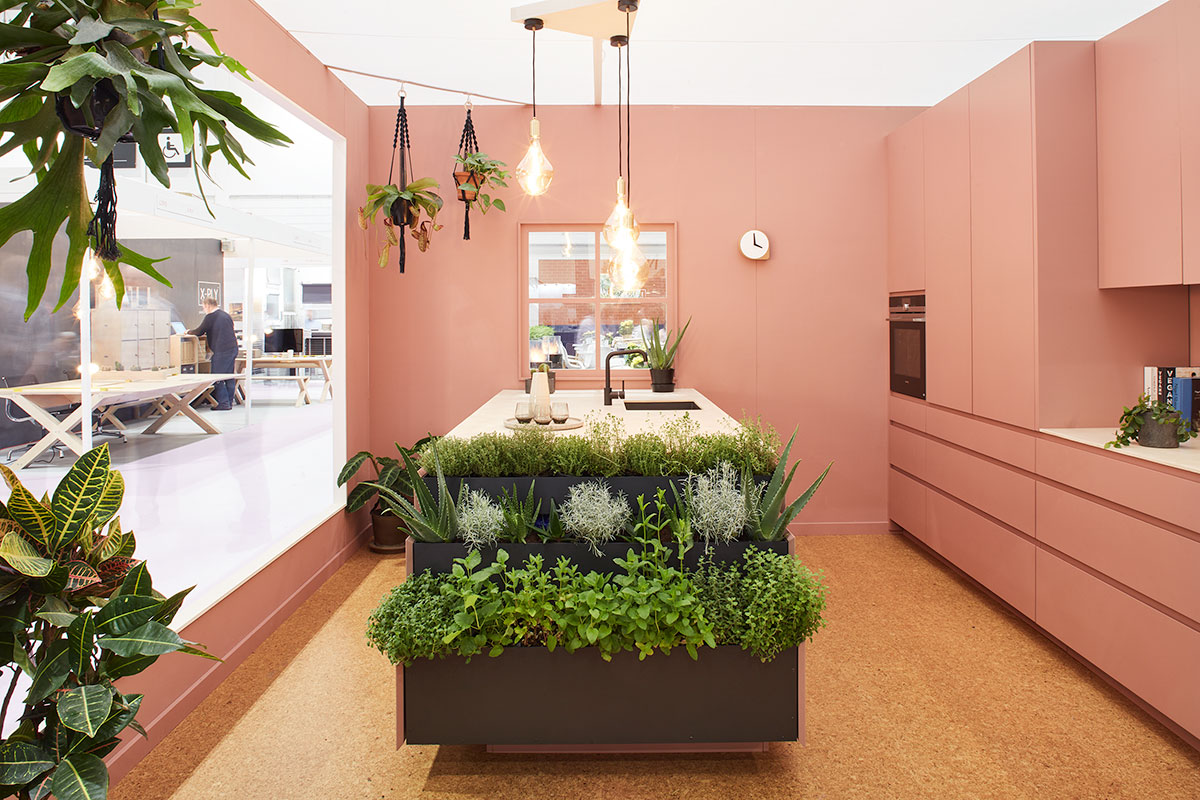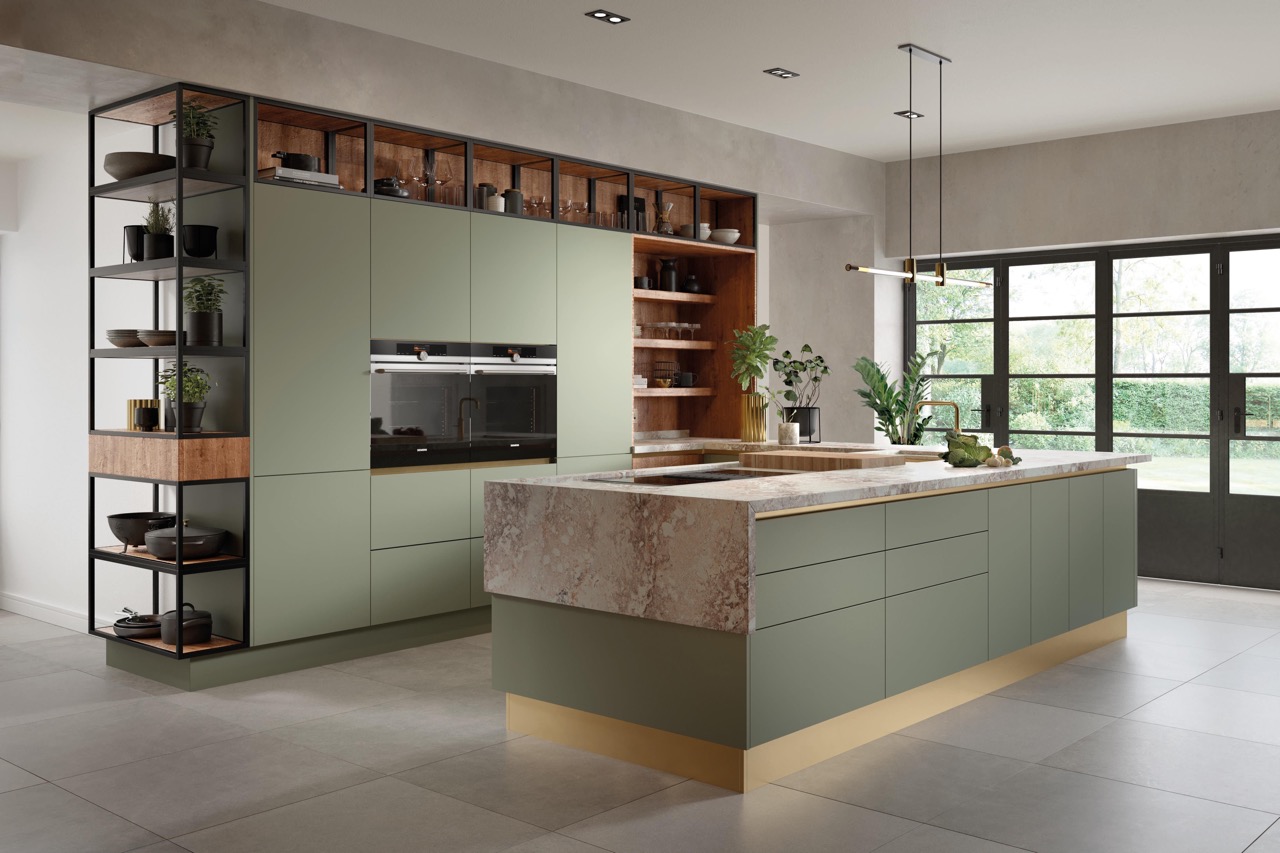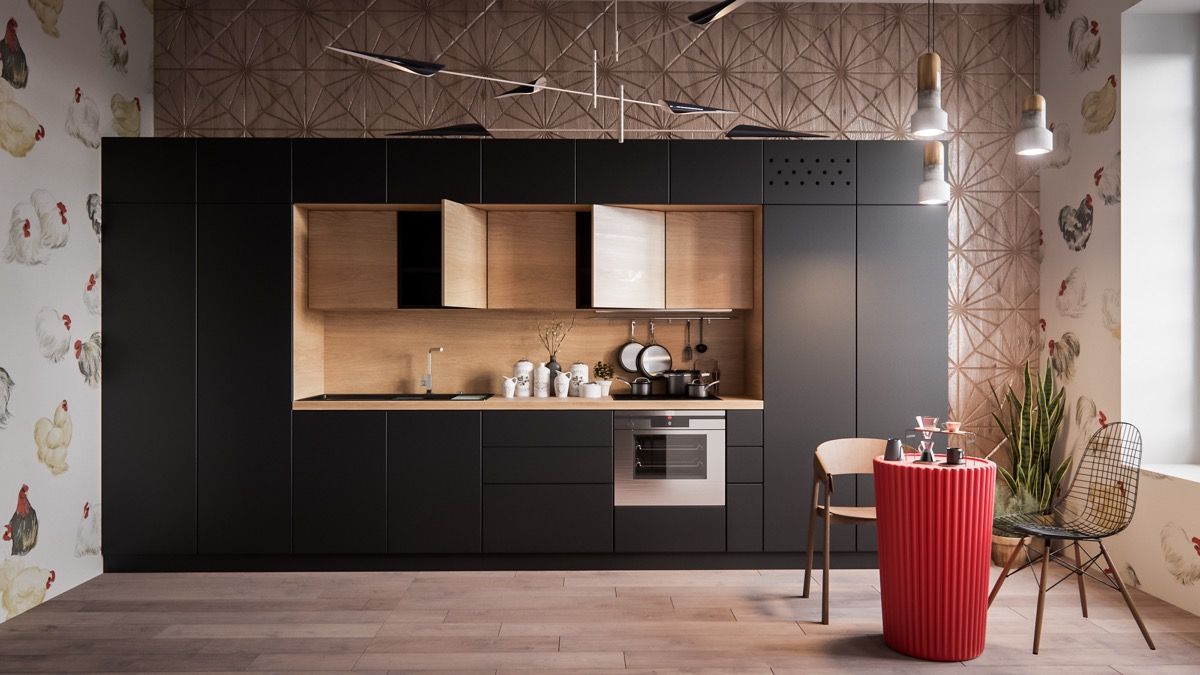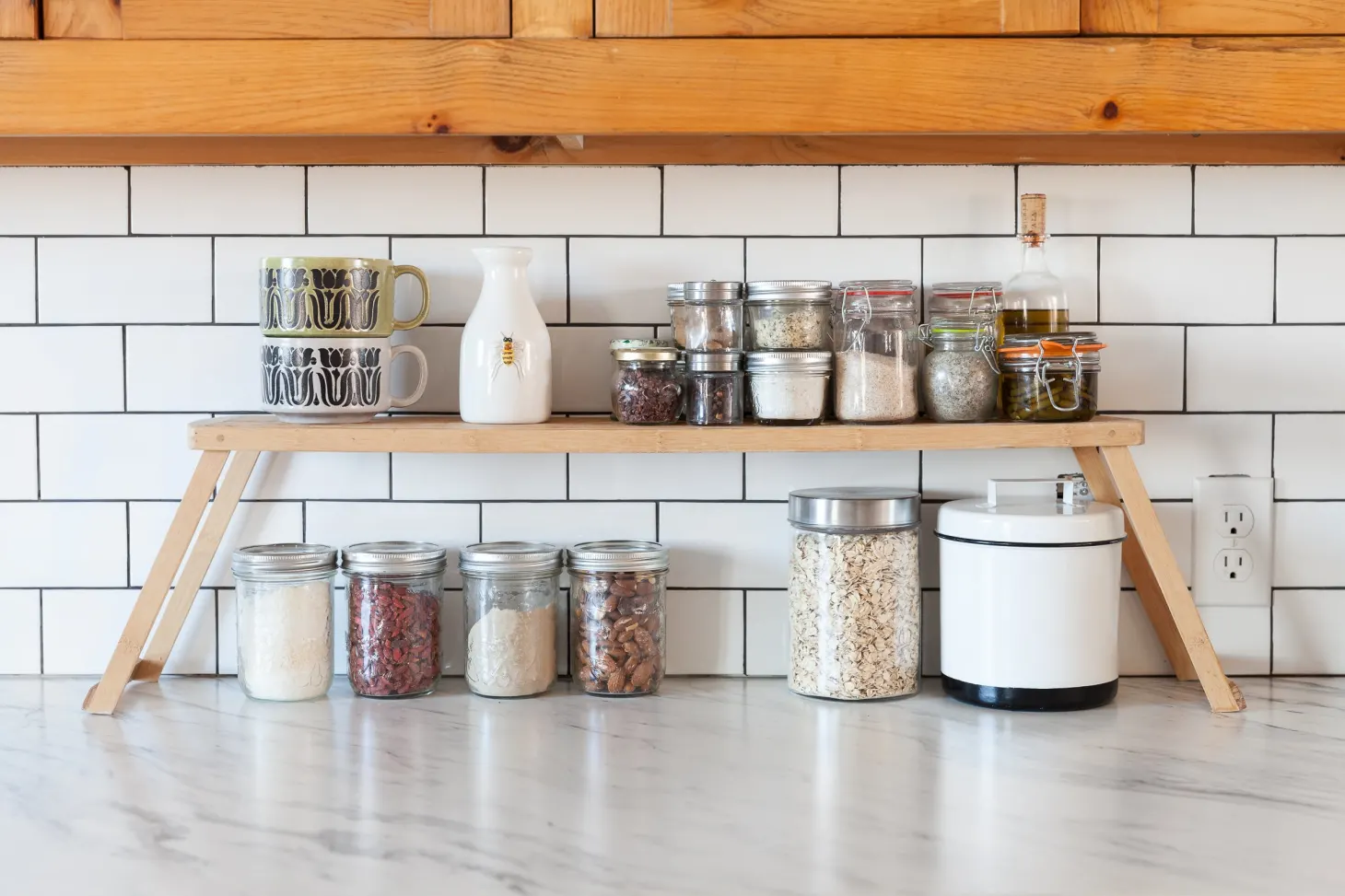Home>Storage Ideas>Kitchen Storage>Sustainable Kitchen Ideas: 19 Ways To An Eco-friendly Space


Kitchen Storage
Sustainable Kitchen Ideas: 19 Ways To An Eco-friendly Space
Modified: January 6, 2024
Discover 19 sustainable kitchen storage ideas for an eco-friendly space. Maximize storage while minimizing waste with our top tips for a greener kitchen.
(Many of the links in this article redirect to a specific reviewed product. Your purchase of these products through affiliate links helps to generate commission for Storables.com, at no extra cost. Learn more)
Introduction
Welcome to the world of sustainable kitchen storage ideas! In today’s environmentally conscious society, it is more important than ever to make eco-friendly choices in every aspect of our lives, including our kitchens. By implementing sustainable practices and utilizing innovative storage solutions, we can create a kitchen that is not only functional and organized but also contributes to a greener planet.
The kitchen is often the heart of the home, a space where delicious meals are prepared and families gather together. However, it is also a space that can generate a significant amount of waste and consume excessive energy and resources if not properly managed. By adopting sustainable kitchen storage ideas, we can reduce our environmental impact and create a more harmonious and efficient space.
In this article, we will explore 19 creative and practical ways to design an eco-friendly kitchen that maximizes storage efficiency while minimizing waste. From using energy-efficient appliances to incorporating sustainable materials, there are countless opportunities to make a positive difference in your kitchen without compromising on style or functionality. So, let’s dive in and discover how to transform your kitchen into a sustainable haven!
Key Takeaways:
- Transform your kitchen into an eco-friendly haven with 19 sustainable storage ideas, from energy-efficient appliances to natural ventilation techniques. Make a positive impact on the planet while enjoying a functional and beautiful kitchen.
- Embrace creativity and practicality to design an eco-friendly kitchen that aligns with your values of sustainability. Every step counts in creating a healthier and more enjoyable kitchen environment for you and your loved ones.
Read more: 9 Ways To Be Sustainable At Home
Use energy-efficient appliances
One of the most effective ways to make your kitchen more sustainable is by using energy-efficient appliances. Traditional appliances consume a significant amount of electricity, contributing to higher energy bills and increased carbon emissions. By investing in energy-efficient models, you can reduce your energy consumption and save money in the long run.
Look for appliances that are ENERGY STAR certified, as they meet strict energy efficiency standards set by the U.S. Environmental Protection Agency (EPA). These appliances use less energy and have features such as programmable settings, low water usage, and power-saving modes. When shopping for a new refrigerator, dishwasher, or oven, check the appliance’s energy efficiency rating and choose the most efficient option within your budget.
In addition to choosing energy-efficient appliances, there are other ways to minimize energy usage in the kitchen. Opt for induction cooktops, which use electromagnetic fields to heat the cookware directly, reducing energy wastage. Use microwaves or toaster ovens for smaller cooking tasks, as they consume less energy than conventional ovens. And always remember to turn off appliances and unplug them when not in use, as even standby mode can draw power.
By using energy-efficient appliances and adopting energy-saving habits in the kitchen, you can significantly reduce your carbon footprint and contribute to a more sustainable future.
Next, let’s explore another important aspect of an eco-friendly kitchen: choosing eco-friendly cookware.
Choose eco-friendly cookware
When it comes to creating a sustainable kitchen, the cookware you choose can make a big difference. Many traditional cookware materials, such as non-stick coatings and certain types of plastics, can release harmful chemicals into the food and the environment. By opting for eco-friendly cookware, you can avoid these risks and reduce your ecological footprint.
One popular choice for eco-friendly cookware is stainless steel. It is durable, non-toxic, and resistant to rust and corrosion. Stainless steel cookware heats evenly and can last for a long time, reducing the need for frequent replacements. Another eco-friendly option is cast iron cookware, which retains heat well and is naturally non-stick when seasoned properly. Cast iron pans can be passed down through generations, making them a sustainable choice.
For those looking for non-toxic non-stick options, ceramic-coated cookware is an excellent alternative. Ceramic coatings are made from natural materials and do not release harmful chemicals when heated. These coatings are also scratch-resistant and easy to clean, making them a convenient choice for environmentally conscious cooks.
When selecting cookware, it’s also important to consider the production process. Opt for brands that prioritize sustainability and ethical manufacturing practices. Look for cookware made from recycled materials or those with a low carbon footprint. Additionally, choose cookware that is easy to repair or replace individual parts, reducing waste and extending its lifespan.
By choosing eco-friendly cookware, you can prepare meals in a healthier and more sustainable way, without compromising on quality or taste.
Next, we will explore the importance of energy-saving lighting in an eco-friendly kitchen.
Opt for energy-saving lighting
Lighting plays a crucial role in creating a functional and inviting kitchen space. But did you know that it is also an opportunity to make your kitchen more sustainable? By opting for energy-saving lighting options, you can reduce your energy consumption and lower your utility bills.
One of the best ways to achieve energy efficiency in kitchen lighting is by using LED bulbs. LED bulbs are highly energy-efficient, using up to 80% less energy than traditional incandescent bulbs. They also have a much longer lifespan, meaning fewer replacements and less waste. LED lighting options are now available in a variety of styles and color temperatures, allowing you to create the desired ambiance in your kitchen while saving energy.
In addition to choosing LED bulbs, you can also make use of natural light to illuminate your kitchen during the day. Consider installing skylights, large windows, or light tubes to maximize the amount of natural light entering your space. Not only will this save energy, but it can also create a brighter and more inviting atmosphere in your kitchen.
Another energy-saving lighting option is installing motion sensors or dimmer switches. These devices can automatically turn off lights when the kitchen is unoccupied or reduce the brightness when less light is needed. This not only saves energy but also extends the lifespan of your bulbs.
Remember to turn off lights when not in use, and make use of task lighting rather than relying on overhead lighting for every task. By implementing these energy-saving lighting strategies, you can create a more sustainable kitchen without sacrificing functionality or style.
Next, let’s explore the benefits of installing low-flow faucets in your kitchen to conserve water.
Install low-flow faucets
Water conservation is an essential part of creating an eco-friendly kitchen. By installing low-flow faucets, you can significantly reduce water waste and decrease your water consumption without compromising the functionality of your kitchen.
Traditional faucets typically have a flow rate of around 2.5 gallons per minute (GPM), which can quickly add up to a substantial amount of water usage. Low-flow faucets, on the other hand, restrict the flow of water to 1.5 GPM or less, helping you conserve water and reduce your water bill.
There are several options for low-flow faucets, including aerators and flow restrictors. Faucet aerators mix air with the water, creating a steady and satisfying flow while using less water. They are easy to install and can be added to existing faucets. Flow restrictors, on the other hand, limit the amount of water that can pass through the faucet, reducing the overall flow rate.
In addition to installing low-flow faucets, it’s important to practice water-saving habits in the kitchen. Avoid letting the tap run unnecessarily while washing dishes or preparing food. Instead, fill a basin with water for rinsing or use a dual-compartment sink to maximize water usage. When washing fruits and vegetables, use a bowl or container filled with water instead of letting the tap run.
By adopting low-flow faucets and water-saving habits, you can significantly reduce your water consumption and contribute to a more sustainable kitchen.
Now that we have explored the importance of water conservation, let’s move on to the next sustainable kitchen idea – composting and recycling.
Compost and recycle
Creating a sustainable kitchen extends beyond energy and water conservation. Proper waste management is a crucial aspect of an eco-friendly space. By composting and recycling, you can significantly reduce the amount of waste that ends up in landfills and contribute to the recycling loop.
Composting is the process of turning organic waste, such as food scraps and yard trimmings, into nutrient-rich soil. Instead of throwing these materials into the trash, you can collect them in a compost bin and let nature do its work. Composting not only reduces landfill waste but also creates a valuable resource that can be used to enrich your garden or houseplants. Look for compost bins specifically designed for indoor or outdoor use, depending on your available space.
Recycling should be a primary focus in your sustainable kitchen. Set up separate recycling bins for materials like plastic, glass, paper, and metal. Make sure to rinse any food containers before recycling them to avoid contamination. It’s also important to educate yourself on your local recycling guidelines to ensure you are properly sorting and disposing of materials.
In addition to composting and recycling, consider reducing waste in the first place. Plan your meals and shopping lists to minimize food waste and avoid excessive packaging. Opt for reusable containers and bags instead of single-use options. By consciously making these choices, you can make a significant impact on reducing waste and creating a sustainable kitchen.
Now that we’ve tackled waste management, let’s explore the next kitchen storage idea – incorporating sustainable flooring materials.
Incorporate sustainable flooring materials
When designing an eco-friendly kitchen, flooring materials play a crucial role in both aesthetics and sustainability. By choosing sustainable flooring options, you can reduce your environmental impact and create a healthier living space.
One popular choice for sustainable kitchen flooring is bamboo. Bamboo is a fast-growing grass that can be harvested without killing the entire plant. It is a renewable resource that is both durable and aesthetically pleasing. Bamboo flooring is available in various styles and colors, providing a beautiful and eco-friendly option for your kitchen.
Cork is another sustainable flooring material that is gaining popularity. It is harvested from the bark of cork oak trees, which regrow after harvesting. Cork flooring is comfortable to walk on, as it has a cushion-like texture and is naturally resistant to mold and mildew. It also acts as an excellent insulator, helping to reduce energy consumption.
If you prefer a more traditional look, consider engineered hardwood flooring made from responsibly sourced and certified wood. Look for products that are Forest Stewardship Council (FSC) certified, indicating that they are sourced from sustainably managed forests. Engineered hardwood is also more resistant to moisture and temperature changes, making it a smart choice for kitchens.
For a truly unique and eco-friendly flooring option, consider salvaged or reclaimed materials. Reclaimed wood, brick, or tile can add character to your kitchen while reducing the demand for new materials. These materials have a history and story behind them, giving your kitchen a one-of-a-kind charm.
Before choosing your flooring material, ensure that it is manufactured using low VOC (volatile organic compounds) finishes and adhesives. VOCs can emit harmful chemicals into the air, negatively impacting indoor air quality.
By incorporating sustainable flooring materials in your kitchen, you can create a beautiful space that is not only visually appealing but also environmentally responsible.
Now, let’s move on to the next kitchen storage idea – using non-toxic cleaning products.
Use non-toxic cleaning products
When it comes to maintaining a clean and healthy kitchen, using non-toxic cleaning products is crucial. Traditional cleaning products often contain harsh chemicals that can be harmful to both your health and the environment. By opting for non-toxic alternatives, you can create a safer and more sustainable cleaning routine.
There are several options for non-toxic cleaning products that are effective in removing dirt, grease, and stains. One simple and affordable option is to make your own cleaning solutions using ingredients like vinegar, baking soda, and lemon juice. These natural ingredients have powerful cleaning properties and are safe for your health and the environment.
You can create an all-purpose cleaner by mixing equal parts water and vinegar in a spray bottle. Add a few drops of essential oils like lavender or tea tree oil for a pleasant scent. Baking soda can be used as a scouring agent to remove tough stains and eliminate odors. Lemon juice is excellent for cutting through grease and leaving surfaces sparkling clean.
If you prefer to purchase cleaning products, look for eco-friendly and non-toxic options available in the market. There are many brands that offer plant-based, biodegradable, and cruelty-free cleaning products that are gentle yet effective. Read labels carefully to ensure that they are free from harsh chemicals like bleach, ammonia, and phosphates.
In addition to choosing non-toxic cleaning products, consider using reusable cleaning tools such as microfiber cloths and mop pads. These can be washed and reused, reducing waste and minimizing the need for single-use disposable cleaning products.
By using non-toxic cleaning products, you can maintain a clean and healthy kitchen while minimizing your impact on the environment. It’s a win-win situation for both you and the planet.
Next, let’s explore the importance of water conservation in an eco-friendly kitchen.
Reduce water waste
Water is a precious resource, and conserving it in the kitchen is essential for creating a sustainable environment. By adopting water-saving habits and implementing water-efficient technologies, you can significantly reduce water waste and make your kitchen more eco-friendly.
One of the most effective ways to reduce water waste in the kitchen is by being mindful of how you use water. Avoid leaving the tap running while you wash dishes or prepare food. Instead, fill a basin with soapy water for washing dishes and rinse them all together. Use a dishwasher if you have one, as it uses less water compared to hand-washing when fully loaded.
Upgrade your kitchen with water-saving appliances and fixtures. Install low-flow faucets and showerheads, which can reduce water usage without compromising performance. Consider investing in a dishwasher with water-saving features, such as eco-mode or sensors that adjust water consumption based on the load.
Fix any leaks in your kitchen promptly. A tiny leak can waste a significant amount of water over time. Regularly check for leaky faucets, pipes, and appliances, and make repairs as soon as possible.
Another way to reduce water waste is by capturing and reusing water. Install a rainwater harvesting system to collect rainwater that can be used for watering plants or cleaning purposes. Additionally, consider using the leftover water from cooking or rinsing fruits and vegetables to water your plants instead of letting it go down the drain.
When it comes to saving water, every drop counts. By being mindful of your water usage and implementing water-saving technologies in your kitchen, you can make a significant impact in preserving this valuable resource.
Now that we’ve explored ways to reduce water waste, let’s move on to the next kitchen storage idea – growing your own herbs and vegetables.
Grow your own herbs and vegetables
One of the most rewarding and sustainable ways to enhance your kitchen is by growing your own herbs and vegetables. Not only does it provide you with fresh and flavorful ingredients for your meals, but it also reduces food waste, minimizes the need for transportation, and promotes a deeper connection with the food you consume.
Starting a kitchen garden can be as simple as growing herbs in small pots on your windowsill or as elaborate as setting up raised beds in your backyard. It all depends on the space you have available and the level of commitment you’re willing to make.
Begin by selecting herbs and vegetables that you frequently use in your cooking. Some commonly grown herbs include basil, rosemary, thyme, and mint, while popular vegetables like tomatoes, peppers, lettuce, and radishes are relatively easy to grow. Research the specific requirements of each plant, such as sunlight, watering, and soil conditions, and provide them with the necessary care and attention.
Not only will growing your own herbs and vegetables provide you with a steady supply of fresh produce, but it also eliminates the need for packaging and reduces your carbon footprint by minimizing transportation. It’s a small but powerful step towards a more sustainable kitchen.
If you have limited outdoor space, consider alternative gardening methods such as vertical gardening or container gardening. Vertical gardens utilize vertical wall spaces or hanging structures to grow herbs and vegetables, while container gardening allows you to grow plants in pots or containers on balconies or patios. Both options maximize space and are perfect for urban dwellers.
Growing your own food also provides an opportunity to teach children about sustainability, healthy eating, and the importance of taking care of the environment. Involving them in the gardening process fosters a sense of responsibility and creates lasting memories.
So, roll up your sleeves, grab a shovel, and start growing your own herbs and vegetables. Your kitchen will be transformed into a sustainable oasis of fresh and delicious flavors.
Next, let’s explore the importance of buying local and organic produce for a greener kitchen.
Buy local and organic produce
Supporting local farmers and choosing organic produce is not only beneficial for your health but also for the environment. When you buy local and organic produce, you contribute to reducing carbon emissions, supporting sustainable farming practices, and enjoying fresh and nutritious food.
Local produce is typically sourced from nearby farms, reducing the distance it travels to reach your kitchen. This means fewer transportation emissions and a smaller carbon footprint. By purchasing locally grown fruits, vegetables, and other food products, you support local agriculture and help strengthen your community’s economy.
In addition to buying local, choosing organic produce further promotes sustainability. Organic farming practices prioritize soil health, biodiversity, and the use of natural fertilizers and pest control methods. By opting for organic foods, you support a system that minimizes chemical inputs, promotes healthier ecosystems, and protects the health of both farmers and consumers.
Shopping at farmers’ markets is an excellent way to access fresh, local, and organic produce. It allows you to connect directly with farmers, learn about their farming methods, and discover a variety of seasonal fruits and vegetables. You can also join community-supported agriculture (CSA) programs, where you receive a weekly or bi-weekly box of freshly harvested produce from local farms.
If farmers’ markets or CSAs are not readily available, look for local and organic options in your grocery store. Many supermarkets now offer dedicated sections for organic produce or label the origin of their fruits and vegetables. You can also consider joining a cooperative that specializes in local, organic, and sustainably sourced food.
Buying local and organic produce not only supports sustainable farming practices but also encourages a healthier lifestyle for you and your family. It’s a win-win situation for your well-being and the environment.
Next, let’s explore ways to minimize food waste in your kitchen for a more sustainable approach to storage and consumption.
Consider using energy-efficient appliances in your kitchen to reduce electricity consumption and lower your carbon footprint. Look for appliances with the Energy Star label for maximum efficiency.
Minimize food waste
Food waste is a significant environmental issue, contributing to greenhouse gas emissions and the depletion of natural resources. Minimizing food waste in your kitchen is not only a sustainable practice but also a way to save money and make the most of the food you have. Here are some strategies to help you reduce food waste:
1. Plan your meals: Plan your meals ahead and create a grocery list based on the ingredients you need. This way, you’ll avoid buying unnecessary items that may end up going to waste.
2. Proper storage: Ensure proper storage of food to extend its shelf life. Use airtight containers, resealable bags, and refrigeration to preserve freshness.
3. First in, first out: Practice the “first in, first out” rule when organizing your pantry and fridge. Place older items in the front and use them before they expire.
4. Utilize leftovers: Get creative with leftovers by repurposing them into new meals or incorporating them into soups, stews, or salads.
5. Composting: Instead of throwing food scraps into the trash, start composting. Composting allows food waste to break down naturally and turns it into nutrient-rich compost for your garden.
6. Freeze excess food: If you have excess food that you won’t be able to consume in time, freeze it for later use. This helps prevent spoilage and allows you to enjoy the food at a later date.
7. Portion control: Opt for smaller portion sizes to avoid overeating and wasting food. You can always go back for more if needed.
8. Donate to those in need: If you have surplus food that is still safe for consumption, consider donating it to local food banks or organizations that help feed those in need.
By implementing these strategies, you can make a significant impact in reducing food waste and contribute to a more sustainable kitchen. Remember, every effort counts!
Now, let’s explore sustainable kitchen storage options to keep your items organized and minimize waste.
Utilize sustainable kitchen storage options
Effective kitchen storage not only keeps your kitchen organized but also promotes sustainability by minimizing waste and maximizing the use of available space. Here are some sustainable kitchen storage ideas to help you create an eco-friendly and efficient kitchen:
1. Use reusable containers: Replace single-use plastic bags and wraps with reusable containers for storing leftovers, meal prep ingredients, and pantry staples. Opt for glass or stainless steel containers, as they are more durable and free from potentially harmful chemicals.
2. Invest in eco-friendly food wraps: Replace plastic cling wraps with reusable and compostable food wraps made from beeswax or plant-based materials. These wraps are washable, reusable, and a great alternative for covering bowls or wrapping sandwiches.
3. Utilize stackable storage solutions: Maximize cabinet and pantry space by using stackable storage solutions to store dry goods, canned foods, and snacks. This allows you to see and access items easily, reducing the chances of forgetting about them and letting them go to waste.
4. Label your items: By labeling containers and jars, you can easily identify the contents and expiration dates. This helps you keep track of what you have and prevents food from spoiling or being forgotten.
5. Use sustainable materials for storage: Consider using sustainable materials for baskets, bins, and drawer organizers. Bamboo, rattan, or woven grass are excellent choices as they are renewable and add a natural touch to your kitchen decor.
6. Organize your fridge efficiently: Arrange your fridge strategically to reduce food waste. Keep perishable items at eye level, so you are more likely to use them before they spoil. Place older items in front to be used first, and dedicate sections for fruits, vegetables, and condiments to maintain their freshness and prevent them from going bad.
7. Incorporate vertical storage: Take advantage of vertical space by installing shelves, hooks, or magnetic strips on the walls to keep frequently used utensils, pots, and pans within easy reach. This frees up counter space and keeps your kitchen clutter-free.
8. Avoid overstocking: Be mindful of your shopping habits and avoid overstocking perishable items. Purchase only what you know you can consume before the expiration date.
By utilizing sustainable kitchen storage options, you can reduce waste, prolong the lifespan of your food, and create a well-organized and eco-friendly kitchen. It’s a win-win for both your sustainability efforts and your culinary adventures!
Next, let’s explore the importance of proper insulation in a sustainable kitchen.
Implement proper insulation
Proper insulation in your kitchen is not only important for maintaining a comfortable temperature but also for energy efficiency and reducing your carbon footprint. By ensuring that your kitchen is well-insulated, you can help regulate indoor temperatures, conserve energy, and create a more sustainable space.
One area where insulation is crucial is around windows and doors. Insulated windows help prevent heat loss during the winter and heat gain during the summer, reducing the need for excessive heating or cooling. Consider installing double-pane or low-emissivity (Low-E) windows, which have a high thermal performance and minimize heat transfer.
Seal any gaps or cracks in windows and doors to prevent drafts and heat loss. Use weatherstripping or caulk to seal these areas, ensuring that your kitchen remains insulated and energy efficient.
Proper roof and wall insulation is also essential for maintaining a comfortable kitchen environment. Insulating the walls can help regulate the indoor temperature, reducing the need for excessive heating or cooling. Consider using eco-friendly insulation materials such as cellulose, wool, or recycled cotton, which have a lower environmental impact compared to traditional insulation materials.
In addition to reducing energy consumption, proper insulation can also help reduce noise pollution in your kitchen. Insulation materials have sound-absorbing properties, creating a quieter and more peaceful environment.
By implementing proper insulation in your kitchen, you can significantly reduce heat loss or gain, conserve energy, and create a more sustainable and comfortable space. It’s a long-term investment that pays off both for the environment and your energy bills.
Next, let’s explore the importance of reducing single-use plastics in your kitchen for a more sustainable and plastic-free storage approach.
Reduce single-use plastics
In today’s world, reducing single-use plastics has become an urgent necessity to protect our environment and promote a sustainable future. The kitchen, with its frequent use of plastic wrap, bags, and disposable containers, is a significant contributor to plastic waste. By making a conscious effort to reduce single-use plastics in your kitchen, you can positively impact the health of our planet.
Here are some practical steps you can take to minimize your reliance on single-use plastics:
1. Use reusable shopping bags: Bring your own reusable bags when grocery shopping to avoid using single-use plastic bags. Keep a few in your car or near the kitchen entrance to make it a convenient habit.
2. Embrace reusable food storage containers: Instead of using plastic wrap or disposable containers, opt for reusable food storage containers made from glass, stainless steel, or BPA-free plastic. These containers can be used repeatedly for storing leftovers, meal prepping, or packing lunches.
3. Ditch plastic water bottles: Invest in a reusable water bottle and fill it with tap water. Carry it with you wherever you go to stay hydrated while avoiding single-use plastic water bottles.
4. Choose alternatives to plastic wrap: Instead of using plastic wrap to cover leftovers or pack sandwiches, consider using beeswax wraps, silicone food covers, or reusable silicone bags. These options provide a reliable seal and can be washed and reused multiple times.
5. Say no to disposable cutlery and straws: Instead of using disposable plastic cutlery and straws, opt for reusable alternatives made from bamboo, stainless steel, or other sustainable materials. Keep a set of reusable cutlery and a metal straw in your bag or kitchen drawer for when you’re on-the-go.
6. Shop in bulk: Whenever possible, buy pantry staples like grains, nuts, and spices from bulk bins using your own reusable containers or bags. This way, you can avoid the excess packaging that often comes with pre-packaged products.
7. Make your own cleaning products: Reduce the need for plastic bottles of cleaning products by making your own using simple ingredients like vinegar, baking soda, and essential oils. You can store your homemade cleaners in reusable spray bottles.
8. Opt for unpackaged produce: When grocery shopping, choose loose fruits and vegetables over those wrapped in plastic. If it’s unavoidable, try to find produce that is packaged in compostable or recyclable materials.
By consciously reducing your reliance on single-use plastics in the kitchen, you not only minimize waste but also inspire others to make sustainable choices. Small changes can have a big impact when it comes to preserving our planet for future generations.
Next, let’s explore sustainable countertop materials for a greener and more eco-friendly kitchen design.
Opt for sustainable countertop materials
When designing or renovating your kitchen, the choice of countertop material is not only critical for aesthetics but also for sustainability. By opting for sustainable countertop materials, you can reduce your environmental impact and create a greener kitchen. Here are some eco-friendly options to consider:
1. Bamboo: Bamboo is a renewable resource that grows rapidly and is highly sustainable. It is as durable and versatile as traditional hardwood but with a lower environmental impact. Bamboo countertops provide a beautiful and natural look to your kitchen.
2. Recycled Glass: Countertops made from recycled glass are an eco-friendly choice. These countertops typically contain post-consumer or post-industrial glass mixed with resin or cement. They come in various colors and provide a unique and vibrant look to your kitchen while diverting glass waste from landfills.
3. Recycled Paper: Countertops made from recycled paper are an innovative and sustainable choice. They are created by compressing layers of recycled paper with a non-toxic resin, resulting in a durable and visually appealing surface. These countertops are often available in a wide range of colors and patterns.
4. Reclaimed Wood: Using reclaimed wood for your countertops adds character and warmth to your kitchen while reducing the demand for new timber. Reclaimed wood is salvaged from old buildings, barns, or furniture and repurposed for a new life as a countertop.
5. Solid Surface Materials: Some solid surface countertop materials, such as those made from recycled acrylic or polyester, offer sustainability benefits. These materials are durable, non-porous, and resistant to stains, scratches, and heat. They can be manufactured with a high percentage of recycled content.
6. Concrete: Concrete countertops can be a sustainable option if made with locally sourced materials and using less energy-intensive production methods. It is a versatile material that can be customized with different finishes and pigments to suit your design preferences.
When considering sustainable countertop materials, also explore the manufacturing process and certifications. Look for products that are made using environmentally friendly practices, with a focus on resource conservation and minimal waste generation. Additionally, check if the countertops are certified by recognized organizations like Cradle to Cradle or GREENGUARD, which evaluate products for their environmental and health impacts.
By selecting sustainable countertop materials, you can create a beautiful and eco-friendly kitchen that aligns with your values of sustainability and responsible consumption.
Now, let’s explore the importance of using natural and biodegradable dishwashing tools in your sustainable kitchen.
Use natural and biodegradable dishwashing tools
Keeping your kitchen clean and dishes sparkling is essential, but using conventional dishwashing tools that are made from synthetic materials and harsh chemicals may be detrimental to the environment and your health. By opting for natural and biodegradable dishwashing tools, you can maintain a sustainable kitchen while keeping your dishes and the planet in pristine condition.
Here are some eco-friendly dishwashing tool alternatives to consider:
1. Natural Fiber Dish Brushes: Instead of using dish brushes with plastic bristles, choose brushes made from natural fibers like coconut husks or plant-based materials. These brushes are biodegradable, renewable, and gentle on your dishes, while effectively removing food particles.
2. Biodegradable Dish Scrubbers: Replace synthetic scrubbers with biodegradable options made from materials like loofah, cotton, or bamboo. These natural scrubbers are gentle yet effective in removing grime and food residue from dishes.
3. Compostable Sponges: Traditional dish sponges are typically made of synthetic materials and release microplastics into the environment when discarded. Opt for compostable sponges made from natural cellulose or plant-based materials. These sponges are biodegradable and can be composted after their useful life.
4. Natural Dish Cloth: Choose dish cloths made from natural fibers such as cotton or linen. These fabrics are absorbent, reusable, and can be easily washed and dried when needed. They are a sustainable and chemical-free alternative to disposable paper towels.
5. Homemade Dish Soap: Consider making your own dish soap using natural ingredients like castile soap, vinegar, and essential oils. Homemade dish soap is a safer and more sustainable alternative to commercial products that often contain harmful chemicals and come in plastic packaging. You can store your homemade dish soap in reusable glass bottles.
6. Wooden Dish Drying Rack: Use a wooden dish drying rack instead of plastic or metal ones. Wooden racks are more sustainable, long-lasting, and can be composted at the end of their life cycle. They add a natural touch to your kitchen decor while providing a space-saving solution.
Remember to properly care for your natural dishwashing tools to extend their lifespan. Rinse and allow them to dry thoroughly after use to prevent the growth of bacteria or mildew.
By utilizing natural and biodegradable dishwashing tools, you minimize your environmental footprint, reduce plastic waste, and create a safer and healthier kitchen for you and the planet.
Now, let’s explore the benefits of choosing energy-efficient windows for your sustainable kitchen.
Choose energy-efficient windows
When it comes to creating a sustainable kitchen, energy-efficient windows play a vital role in improving insulation, reducing energy consumption, and enhancing the overall comfort of your space. By choosing windows with superior energy efficiency, you can create an eco-friendly kitchen that not only saves energy but also enhances natural light and minimizes outside noise.
Energy-efficient windows are designed to minimize heat transfer, keeping your kitchen cool in the summer and warm in the winter. They are typically constructed with advanced technology, including low-emissivity (Low-E) coatings, multiple panes, and insulating gas fills between the layers of glass.
Low-E coatings are thin, transparent layers applied to the glass that reflect infrared heat, preventing it from entering or escaping the interior of your kitchen. This helps to reduce the need for excessive heating or cooling, subsequently lowering your energy bills.
Multiple panes, often in double or triple-glazed configurations, provide additional insulation by creating layers of air or gas trapped between the glass. This acts as a barrier against heat transfer, improving energy efficiency and reducing condensation on the windows.
Insulating gas fills, such as argon or krypton, are typically used in between the panes of glass to reduce heat conduction. These gases have low thermal conductivity, minimizing heat transfer and enhancing the overall energy efficiency of the windows.
In addition to energy efficiency, consider other factors for sustainable windows, such as the frame material. Opt for frames made from sustainable materials like wood or fiberglass, which have lower environmental impacts compared to vinyl or aluminum frames.
Energy-efficient windows not only reduce energy consumption but also enhance natural lighting in your kitchen. With better insulation and advanced coatings, these windows allow ample natural light to enter your space, reducing the need for artificial lighting during the day and creating a more inviting and comfortable environment.
When selecting energy-efficient windows, look for certifications such as ENERGY STAR® to ensure that they meet strict energy efficiency standards. These certifications guarantee that the windows have been tested and proven to be energy-efficient and environmentally friendly.
By choosing energy-efficient windows for your kitchen, you not only contribute to a greener environment but also enjoy cost savings and a more comfortable living space.
Next, let’s explore the concept of reusing and upcycling kitchen items to minimize waste and create a unique and sustainable kitchen.
Reuse and upcycle kitchen items
Creating a sustainable kitchen doesn’t always mean buying new items. In fact, reusing and upcycling kitchen items can not only reduce waste but also add character and uniqueness to your space. By giving new life to old or unused items, you can create a sustainable and personalized kitchen while minimizing your environmental impact.
Here are some creative ways to reuse and upcycle kitchen items:
1. Repurpose glass jars: Instead of throwing away glass jars, give them a second life as storage containers for spices, dried herbs, or bulk pantry items. You can also use them as drinking glasses or to store homemade sauces or jams.
2. Transform wooden crates or pallets: Turn old wooden crates or pallets into shelves or storage units. They can be sanded, painted, or stained to match your kitchen decor. These repurposed items not only provide functional storage but also bring a rustic and eco-friendly touch to your kitchen.
3. Upcycle wine bottles: Wine bottles can be upcycled into decorative items or functional pieces. Fill them with colorful dried herbs or flowers to create a unique centerpiece or transform them into stylish and eco-friendly drinking glasses.
4. Reuse tin cans: Tin cans can be transformed into various kitchen storage solutions. Remove the label, wash them thoroughly, and use them to organize utensils, hold cooking tools, or plant small herbs. They can be painted or covered with fabric to match your kitchen decor.
5. Repurpose old cutting boards: Instead of disposing of old cutting boards, repurpose them as serving platters or decorative signs. Sand them down, apply food-safe finishes, and use them for presenting cheese, bread, or charcuterie.
6. Give new life to old furniture: Consider giving old furniture pieces a makeover to fit your kitchen style. For example, an old dresser can be transformed into a kitchen island or a vintage table can be repurposed as a kitchen workspace.
7. Reuse cloth scraps: If you have fabric scraps or old kitchen towels, repurpose them into reusable napkins, dish cloths, or pot holders. Cut them into desired sizes, hem the edges, and enjoy a sustainable and stylish addition to your kitchen.
Reusing and upcycling kitchen items not only reduces waste but also adds a unique and personal touch to your kitchen design. Get creative, think outside the box, and let your imagination guide you in finding innovative ways to repurpose items that would otherwise end up in landfills.
Before discarding any item, consider if there are alternative functions or possibilities for it in your kitchen. With a little creativity, you can transform the old into something new and contribute to a more sustainable kitchen.
Lastly, let’s explore the importance of incorporating natural ventilation techniques for a healthier and eco-friendly kitchen environment.
Incorporate natural ventilation techniques
In a sustainable kitchen, proper ventilation is essential for maintaining a healthy and comfortable space. While mechanical ventilation systems can be effective, incorporating natural ventilation techniques can contribute to a more eco-friendly environment by reducing energy consumption and promoting air circulation. Here are some strategies to incorporate natural ventilation in your kitchen:
1. Windows and Doors: Open windows and doors to allow fresh air to enter your kitchen. Cross-ventilation is especially effective in improving air circulation. Positioning windows or doors on opposite sides of the room creates a pathway for air to flow through, flushing out stale air and odors.
2. Skylights and Roof Vents: Installing skylights or roof vents can enhance natural ventilation. These features allow warm air to escape through the roof while drawing in cool air from windows or doors, creating a natural airflow. This helps regulate temperature and reduce the need for artificial cooling systems.
3. Range Hoods: Use a range hood with an external vent to remove airborne pollutants, heat, and cooking odors. A range hood helps extract smoke and grease particles from the kitchen, improving air quality and reducing the need for excessive cleaning. It’s crucial to select an energy-efficient range hood to minimize energy consumption.
4. Exhaust Fans and Ventilation Shafts: Installing exhaust fans or ventilation shafts can effectively remove stale air, smoke, and moisture from your kitchen. Place these fans near high-moisture areas like sinks or stovetops to prevent the buildup of condensation and humidity.
5. Natural Materials: Incorporating natural materials in your kitchen can contribute to better indoor air quality. Choose materials like wood, bamboo, or stone, which have low-emission properties, compared to synthetic or chemically treated materials that may release volatile organic compounds (VOCs).
6. Awnings and Shades: Install awnings or shades over windows to block direct sunlight during hot seasons. This prevents excessive heat gain and reduces the need for air conditioning, promoting a more energy-efficient environment.
Remember to consider your local climate and weather patterns when implementing natural ventilation techniques. While natural ventilation is beneficial, maintain a balance to ensure the comfort and safety of your kitchen environment.
By incorporating natural ventilation techniques, you improve indoor air quality, reduce the reliance on artificial cooling systems, and minimize energy consumption. This makes your kitchen more eco-friendly, healthier, and a more pleasant space to spend time in.
With these nineteen kitchen storage ideas, you can transform your kitchen into an eco-friendly space that not only looks great but also minimizes waste, reduces energy consumption, and promotes a sustainable lifestyle. By making conscious choices and incorporating sustainable practices, you can contribute to a greener future while enjoying a functional and beautiful kitchen.
Remember, every step toward sustainable kitchen storage makes a difference. Begin implementing these ideas today and enjoy the benefits of an organized, efficient, and eco-friendly kitchen.
Conclusion
Creating an eco-friendly kitchen with efficient storage solutions not only benefits the environment but also enhances your culinary experience. By incorporating the nineteen kitchen storage ideas outlined in this article, you can transform your kitchen into a sustainable space that minimizes waste, reduces energy consumption, and promotes a greener lifestyle.
From using energy-efficient appliances and opting for eco-friendly cookware to composting, recycling, and incorporating natural ventilation techniques, there are numerous ways to make your kitchen more sustainable. By being mindful of your choices and making small changes, you can significantly reduce your environmental impact while enjoying a beautiful and functional kitchen.
Remember to choose sustainable materials for countertops, flooring, and storage options. Reuse and upcycle kitchen items to give them a second life, and opt for natural and biodegradable dishwashing tools. Incorporate energy-efficient windows and proper insulation to create a well-insulated and energy-saving space. Finally, minimize food waste, buy local and organic produce, and reduce the use of single-use plastics to further enhance the sustainability of your kitchen.
The transition to a sustainable kitchen may take time, but every step counts. Embrace the creativity and practicality involved in designing an eco-friendly kitchen that aligns with your values of sustainability and responsible living. Your efforts will not only benefit the planet but also create a healthier and more enjoyable kitchen environment for you and your loved ones.
So, let’s embark on this journey of sustainable kitchen storage ideas together and make a positive impact on our planet, one kitchen at a time!
Frequently Asked Questions about Sustainable Kitchen Ideas: 19 Ways To An Eco-friendly Space
Was this page helpful?
At Storables.com, we guarantee accurate and reliable information. Our content, validated by Expert Board Contributors, is crafted following stringent Editorial Policies. We're committed to providing you with well-researched, expert-backed insights for all your informational needs.












0 thoughts on “Sustainable Kitchen Ideas: 19 Ways To An Eco-friendly Space”